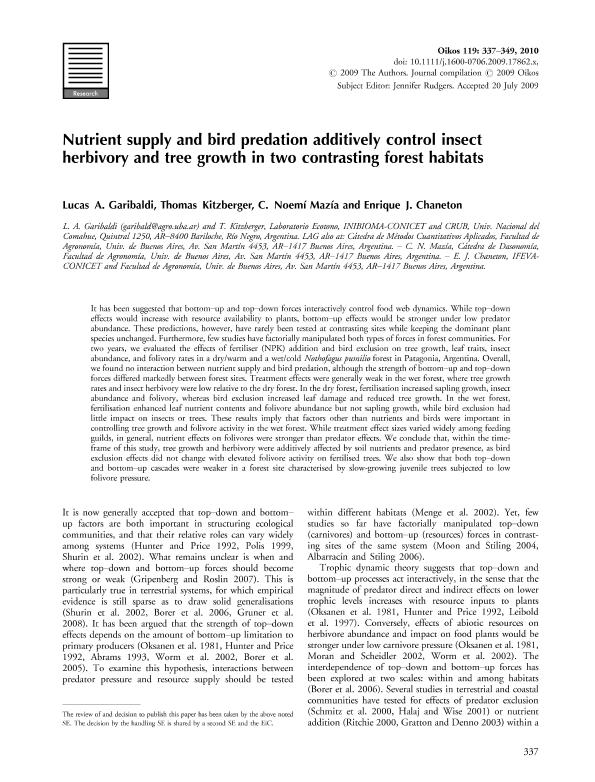Mostrar el registro sencillo del ítem
dc.contributor.author
Garibaldi, Lucas Alejandro

dc.contributor.author
Kitzberger, Thomas

dc.contributor.author
Mazía, Cristina Noemí

dc.contributor.author
Chaneton, Enrique Jose

dc.date.available
2019-03-18T18:59:29Z
dc.date.issued
2010-02
dc.identifier.citation
Garibaldi, Lucas Alejandro; Kitzberger, Thomas; Mazía, Cristina Noemí; Chaneton, Enrique Jose; Nutrient supply and bird predation additively control insect herbivory and tree growth in two contrasting forests. Oikos; Wiley Blackwell Publishing, Inc; Oikos; 119; 2; 2-2010; 337-349
dc.identifier.issn
0030-1299
dc.identifier.uri
http://hdl.handle.net/11336/71912
dc.description.abstract
It has been suggested that bottom-up and top-down forces interactively control food web dynamics. While top-down effects would increase with resource availability to plants, bottom-up effects would be stronger under low predator abundance. These predictions, however, have rarely been tested at contrasting sites while keeping the dominant plant species unchanged. Furthermore, few studies have factorially manipulated both types of forces in forest communities. For two years, we evaluated the effects of fertiliser (NPK) addition and bird exclusion on tree growth, leaf traits, insect abundance, and folivory rates in a dry/warm and a wet/cold Nothofagus pumilio forest in Patagonia, Argentina. Overall, we found no interaction between nutrient supply and bird predation, although the strength of bottom-up and top-down forces differed markedly between forest sites. Treatment effects were generally weak in the wet forest, where tree growth rates and insect herbivory were low relative to the dry forest. In the dry forest, fertilisation increased sapling growth, insect abundance and folivory, whereas bird exclusion increased leaf damage and reduced tree growth. In the wet forest, fertilisation enhanced leaf nutrient contents and folivore abundance but not sapling growth, while bird exclusion had little impact on insects or trees. These results imply that factors other than nutrients and birds were important in controlling tree growth and folivore activity in the wet forest. While treatment effect sizes varied widely among feeding guilds, in general, nutrient effects on folivores were stronger than predator effects. We conclude that, within the time-frame of this study, tree growth and herbivory were additively affected by soil nutrients and predator presence, as bird exclusion effects did not change with elevated folivore activity on fertilised trees. We also show that both top-down and bottom-up cascades were weaker in a forest site characterised by slow-growing juvenile trees subjected to low folivore pressure. © 2009 The Authors.
dc.format
application/pdf
dc.language.iso
eng
dc.publisher
Wiley Blackwell Publishing, Inc

dc.rights
info:eu-repo/semantics/openAccess
dc.rights.uri
https://creativecommons.org/licenses/by-nc-sa/2.5/ar/
dc.subject
Herbivory
dc.subject
Nutrients Adittion
dc.subject
Forests
dc.subject.classification
Otras Ciencias Biológicas

dc.subject.classification
Ciencias Biológicas

dc.subject.classification
CIENCIAS NATURALES Y EXACTAS

dc.title
Nutrient supply and bird predation additively control insect herbivory and tree growth in two contrasting forests. Oikos
dc.type
info:eu-repo/semantics/article
dc.type
info:ar-repo/semantics/artículo
dc.type
info:eu-repo/semantics/publishedVersion
dc.date.updated
2019-03-08T20:29:32Z
dc.journal.volume
119
dc.journal.number
2
dc.journal.pagination
337-349
dc.journal.pais
Reino Unido

dc.journal.ciudad
Londres
dc.description.fil
Fil: Garibaldi, Lucas Alejandro. Consejo Nacional de Investigaciones Científicas y Técnicas. Centro Científico Tecnológico Conicet - Patagonia Norte. Instituto de Investigaciones en Biodiversidad y Medioambiente. Universidad Nacional del Comahue. Centro Regional Universidad Bariloche. Instituto de Investigaciones en Biodiversidad y Medioambiente; Argentina. Universidad de Buenos Aires. Facultad de Agronomía. Departamento de Métodos Cuantitativos y Sistemas de Información; Argentina
dc.description.fil
Fil: Kitzberger, Thomas. Consejo Nacional de Investigaciones Científicas y Técnicas. Centro Científico Tecnológico Conicet - Patagonia Norte. Instituto de Investigaciones en Biodiversidad y Medioambiente. Universidad Nacional del Comahue. Centro Regional Universidad Bariloche. Instituto de Investigaciones en Biodiversidad y Medioambiente; Argentina
dc.description.fil
Fil: Mazía, Cristina Noemí. Consejo Nacional de Investigaciones Científicas y Técnicas; Argentina. Universidad de Buenos Aires. Facultad de Agronomia. Departamento de Producción Vegetal. Cátedra de Dasonomia; Argentina
dc.description.fil
Fil: Chaneton, Enrique Jose. Consejo Nacional de Investigaciones Científicas y Técnicas. Oficina de Coordinación Administrativa Parque Centenario. Instituto de Investigaciones Fisiológicas y Ecológicas Vinculadas a la Agricultura. Universidad de Buenos Aires. Facultad de Agronomía; Argentina
dc.journal.title
Oikos

dc.relation.alternativeid
info:eu-repo/semantics/altIdentifier/doi/https://doi.org/10.1111/j.1600-0706.2009.17862.x
dc.relation.alternativeid
info:eu-repo/semantics/altIdentifier/url/https://onlinelibrary.wiley.com/doi/abs/10.1111/j.1600-0706.2009.17862.x
Archivos asociados
